
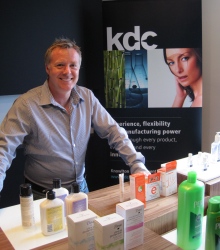
Photo by Andrew Joseph
It’s always much easier to talk of thinking outside the proverbial box than actually pushing the envelope of existing products and technologies on a daily basis like the folks at KDC (Knowlton Development Corporation), one of North America’s leading contract manufacturers of personal-care products with an insatiable appetite for packaging product and process innovation—backed up with a world-class manufacturing skill-set to see many of its pioneering ideas go on to become major marketplace successes.
Headquartered in Knowlton, Que., the KDC group runs a three-pillared network of highly-efficient third-party manufacturing and co-packing facilities—including the Knowlton-based site co-shared by LEK, Inc. and ItalHair North America Ltd., Body Blue 2006 Inc. of Mississauga, Ont., and Tri Tech Labs in Lynchburg, Va.—to serve a rapidly growing client base of personal-care, hygiene and health-and-beauty brand-owners, including industry superpowers such as Procter & Gamble (P&G) and Johnson & Johnson (J&J).
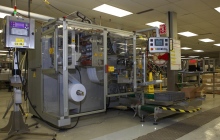
Photo by Steve Pellerin
Totaling over a million square feet of production space, the three plants have continued to post impressive growth numbers even during the past recession, according to KDC vice-president of sales and business development Duncan Coopland, in large part thanks to the company’s
unwavering commitment to product innovation and quality.
“We’re all about innovation: It’s not only part of our name, it’s what we do,” Coopland told Canadian Packaging on a recent visit to the company’s recently-opened KDC Innovation Group facility in west-end Toronto—a focused product research and development unit operating as a sort of a “innovation think-tank” for turning next generation product and packaging developments into commercialized reality.
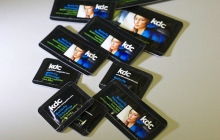
Photo courtesy of EasyPack Solutions Inc.
“This is what we call our think-tank—where we really examine the current market trends, while drawing from our group’s knowledge, insights and participation in the industry to develop novel concepts and technologies that enable our customers to arrive at the forefront of those trends,” explains Coopland.
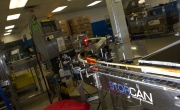
Photos by Steve Pellerin
“We wanted to create a site with a really diverse environment that encourages dialogue, innovation, idea generation and, ultimately, success,” he adds.
“I really believe that we’ve done exactly what we set out to do, as this place has already helped encourage our employees to think outside the box when conceiving of new personal-care products and the new ways to package them.
“This building is essentially a customer innovation center, which connects the R&D groups of each of our manufacturing sites to nurture new business development opportunities and innovation—partnered up with the actual product development.”
According to KDC vice-president of innovation and marketing Natasha Lebel, the Innovation Group unit is mandated with developing accurate three- to five-year projections for various product segments and categories within the personal-care markets, while also developing an “innovation network” that specifically focuses on sustainable technologies.
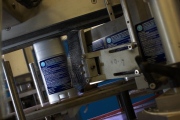
Photo by Steve Pellerin
This often involves engaging various authoritative outside experts in the fields of chemistry and packaging to partake in KDC’s R&D efforts—aimed at bringing to market new proprietary technologies and products ranging from deodorants and antiperspirants to various liquid surfactant systems (soaps).
Says Lebel: “The center is a designed as a gathering space for customers and KDC partners alike—a place where we are not distracted by the routine day-to-day activities, so that we are able to fully explore the ‘what-ifs’ of the marketplace.
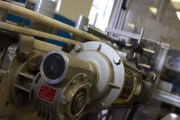
Photo by Steve Pellerin
“It’s also a place for discussion on the future: the future of the market, the future of a customer’s brand, or the future of the industry,” Lebel adds, citing the company’s self-styled mantra of continuous engineering of greater quality and value into its products; connecting with emerging technologies; partnering with the best-in-class technology suppliers; and bringing the future of personal-care products to its clients faster.
Although it’s only been in operation for about a half-year, the KDC Innovation Group unit is already living up to its promise and expectations, according to Coopland and Levy, with several exciting developments in the works and edging closer to commercial launches.
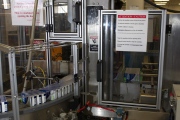 <
div style="width:180px;font-size:11px;">LEK uses a Nenotech SW T30 sleevewrapper and heat-tunnel to pack cartons of aerosol spray-cans.
<
div style="width:180px;font-size:11px;">LEK uses a Nenotech SW T30 sleevewrapper and heat-tunnel to pack cartons of aerosol spray-cans.Photo by Steve Pellerin
One of its more noteworthy new endeavors is geared towards the introduction of the so-called Butterfly unidose packaging technology into the North American markets, with the company’s LEK facility in Knowlton recently becoming the first contract packaging plant in North America to have installed the patented Easysnap machine that is designed specifically for packaging viscous fluids and formulations into flat, easy-to-open, single-dose sachets.
Engineered and manufactured in Italy, this high-performance automatic vertical form-fill-seal (V/F/F/S) machine incorporates patented variable-depth scoring technology that ensures precise and smooth dispensing of a wide range of liquid and viscous products into three different-sized standard Butterfly packs—40×50-mm, 40×80-mm and 60×100-mm—which are formed on the machine by repeatedly joining two concurrently-running webs to construct fully-sealed, high-barrier, rectangular plastic packages with ultra-slim profiles.
Flexible enough to dispense precise product quantities from one to 30 ml, the Easysnap machine and the Butterfly sachets—so named on the account of wing-like movement of the package when it is opened up along the centered perforation by bending the opposite panels inwards with fingers—are the most revolutionary developments in unidose packaging in recent memory, according to Benny Chiavetti, president of EasyPack Solutions Inc. in Brantford, Ont.
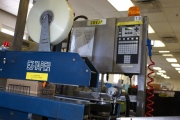
Photo by Steve Pellerin
Chiavetti says the Butterfly offers travelers a far more convenient and space-efficient packaging option than tubes or bottles, while also giving marketers a choice of using the sachets in various product multipacks or as an easy-to-insert product sample.
Moreover, the sachet’s durable, high-barrier construction that combines a rigid-plastic backing with a flexible-film front layer, does an optimal job in terms of meeting the various industry-specific shelf-life requirements, he adds, while the easy-squeeze dispensing of the packaged contents ensures minimal product waste—a critical consideration for many OTC (over-the-counter) pharmaceutical formulations.
“The sky really is the limit for this revolutionary packaging technology,” echoes Coopland.
“Along with personal-care products like hair-gels, shampoos, soaps, sunscreens, moisturizers or toothpastes, the Butterfly is also the perfect package for OTCs and products that should never come into contact with the mouth, such as laundry detergent, which cannot be packaged in a conventional sachet that you may be tempted to tear with your teeth—like the standard ketchup sachets, for example.
“We are very excited by the possibilities, and we know our customers are as well,” he states.
“This technology provides a perfect example of how we strive to partner with great innovators and like-minds.”
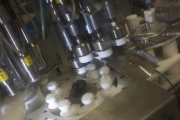
Photo by Steve Pellerin
As for other recent KDC product innovations, Coopland says he is very encouraged by the company’s recent development of the ZEA Natural Deodorant platform—a patent-pending, all-natural deodorant stick that replaces the traditional petroleum-based propylene glycol with an all-natural propanediol alternative derived from corn sugar.
Manufactured by DuPont Tate & Lyle Bio Products, the biodegradable Zemea glycol substitute is said to consume 40 per cent less energy to manufacture than propylene glycol—thereby providing significant savings in GHG (greenhouse-gas) emissions to produce a key deodorant-stick ingredient that accounts for up to 60 per cent of the total contents.
Lebel explains that combining the propanediol with other natural ingredients, such as grapefruit seed extract and sodium bicarbonate, has enabled KDC to develop an all-natural, healthier and more efficacious antiperspirant product that is also completely free of synthetic chemicals like parabens, triclosan, aluminum and silicones—while still providing consumers with effective all-day protection.
“The reality of our industry is that if we had gone to our customers with new concepts like these five years ago, many would not have been interested because they operated under the impression that R&D had to be developed within their own walls,” remarks Coopland, stressing that KDC’s open-door approach to sharing its research findings with clients and partners has ultimately helped overcome that instinctive reluctance.
“With all the R&D and innovation capabilities at our disposal nowadays,” he says, “our clients can clearly see for themselves that a company like ours can really enable them to focus more on what they do best—branding, marketing and distribution.

Photo by Steve Pellerin
“By creating the future today,” Coopland sums up, “the KDC Innovation Group will continue to position itself and its contract manufacturing customers ahead of the competition.
“It’s just a matter of allowing ourselves and our customers to think outside of the proverbial box—to ensure that KDC and its customers will remain successful long into the future.”
Advertisement

